This week in Sam vs. The Internet I take on a deck that pushing up the popularity charts week in and week out since its release. Kess, Dissident MageKess, Dissident Mage is not normally the kind of commander I like to write about as she doesn’t facilitate a specific strategy and instead supports generic “goodstuff” style control decks. However, when a friend who plays mostly legacy asked me to build him a Grixis control deck to get him into EDH I knew what I had to do. Much like Shota Yasooka building his decks the night before Worlds, there is a certain ratio that you grow accustomed to when constructing a control deck. It’s so easy to just grab the right cards out of your binder and jam them together with some lands. The trick is when it comes to EDH, you can’t break it down to X removal spells, Y card draw spells, and Z win conditions because the diversity of threats you have to deal with in a game of EDH makes it such that you also need A ways to deal with enchantments, B ways to deal with graveyards, C ways to get around hexproof, D ways to blow up artifacts, Q ways to recur cards, and I haven’t even decided on what letter to use for indestructible.
The Right Stuff
This had me thinking, sure I could toss the best control spells all in one place, but what would that actually accomplish? With Kess it’s clear that counterspells aren’t as good as normal as you can’t reuse them with Kess’s ability. Having played against Kess decks a couple times now at my local Commander Night one thing I’ve noticed is that, while they may sometimes have the most powerful removal spell available to them, it’s not always as good the second time. A card like VandalblastVandalblast may seem great as you can cast it for its overload cost from the graveyard with Kess, but blowing all the artifacts up multiple times is only useful in a really intense game with multiple artifact-focused decks. The problem came when the Kess player really only needed SmeltSmelt from their VandalblastVandalblast but then had no answer to a late-game Purphoros, God of the ForgePurphoros, God of the Forge. So how do we build a control deck that is powerful enough to win a multiplayer game, while still being flexible enough to handle the same?
The answer lies in the question itself: modal spells have plenty of power. Most modal spells charge a slight premium for their flexibility, however in a format like EDH where things usually don’t start kicking off until around turn four or five we can afford to be a little slow. With this in mind I set to taking apart a traditional Kess list and replacing as many of the cards I could with modal spells that included a similar effect to the original spell. Here’s the result:
Commander (1)
- 1 Kess, Dissident MageKess, Dissident Mage
Creatures (11)
- 1 GuttersnipeGuttersnipe
- 1 Young PyromancerYoung Pyromancer
- 1 Dualcaster MageDualcaster Mage
- 1 Snapcaster MageSnapcaster Mage
- 1 Docent of PerfectionDocent of Perfection
- 1 Goblin ElectromancerGoblin Electromancer
- 1 The Locust GodThe Locust God
- 1 Baral, Chief of ComplianceBaral, Chief of Compliance
- 1 Jace, Vryn's ProdigyJace, Vryn's Prodigy
- 1 Talrand, Sky SummonerTalrand, Sky Summoner
- 1 Solemn SimulacrumSolemn Simulacrum
Artifacts (9)
- 1 Chromatic LanternChromatic Lantern
- 1 Coalition RelicCoalition Relic
- 1 Dimir SignetDimir Signet
- 1 Izzet SignetIzzet Signet
- 1 Primal AmuletPrimal Amulet
- 1 Rakdos SignetRakdos Signet
- 1 Sol RingSol Ring
- 1 Talisman of DominanceTalisman of Dominance
- 1 Talisman of IndulgenceTalisman of Indulgence
Enchantments (3)
- 1 Sunbird's InvocationSunbird's Invocation
- 1 Swarm IntelligenceSwarm Intelligence
- 1 Search for AzcantaSearch for Azcanta
Planeswalkers (2)
- 1 Chandra, the FirebrandChandra, the Firebrand
- 1 Dack FaydenDack Fayden
Instants (20)
- 1 AbradeAbrade
- 1 Ancient ExcavationAncient Excavation
- 1 Comet StormComet Storm
- 1 Crosis's CharmCrosis's Charm
- 1 Cyclonic RiftCyclonic Rift
- 1 Fact or FictionFact or Fiction
- 1 ForbidForbid
- 1 Forbidden AlchemyForbidden Alchemy
- 1 Frantic SearchFrantic Search
- 1 IntuitionIntuition
- 1 Izzet CharmIzzet Charm
- 1 Kolaghan's CommandKolaghan's Command
- 1 Mystic ConfluenceMystic Confluence
- 1 Shred MemoryShred Memory
- 1 SilumgarSilumgar
- 1 StarstormStarstorm
- 1 TerminateTerminate
- 1 UnsubstantiateUnsubstantiate
- 1 Volcanic OfferingVolcanic Offering
- 1 Wretched ConfluenceWretched Confluence
Sorceries (16)
- 1 Anger of the GodsAnger of the Gods
- 1 Cathartic ReunionCathartic Reunion
- 1 Collective DefianceCollective Defiance
- 1 Cruel UltimatumCruel Ultimatum
- 1 Decree of PainDecree of Pain
- 1 Fiery ConfluenceFiery Confluence
- 1 GambleGamble
- 1 Hour of DevastationHour of Devastation
- 1 Incendiary CommandIncendiary Command
- 1 Past in FlamesPast in Flames
- 1 Profane CommandProfane Command
- 1 Rite of RuinRite of Ruin
- 1 SleepSleep
- 1 Torment of HailfireTorment of Hailfire
- 1 Wheel of FortuneWheel of Fortune
- 1 WindfallWindfall
Lands (38)
- 1 Boseiju, Who Shelters AllBoseiju, Who Shelters All
- 1 Geier Reach SanitariumGeier Reach Sanitarium
- 1 Urborg, Tomb of YawgmothUrborg, Tomb of Yawgmoth
- 1 Bloodstained MireBloodstained Mire
- 1 Command TowerCommand Tower
- 1 Desolate LighthouseDesolate Lighthouse
- 1 Polluted DeltaPolluted Delta
- 1 Reliquary TowerReliquary Tower
- 1 Scalding TarnScalding Tarn
- 1 Steam VentsSteam Vents
- 1 Volcanic IslandVolcanic Island
- 1 Underground SeaUnderground Sea
- 1 Watery GraveWatery Grave
- 1 BadlandsBadlands
- 1 Blood CryptBlood Crypt
- 8 IslandIsland
- 8 MountainMountain
- 7 SwampSwamp
I really like this list, and can’t wait to test it out in the real world. I’ve played a deck before that was 5-color all charms deck, and it was a complete blast to play as I always had something to do. That thing didn’t always have relevance to the boardstate, but even then it was always entertaining. There are a couple upgrades that I would like to call attention to specifically because I think they’re more than they seem.
The "Goodstuff"
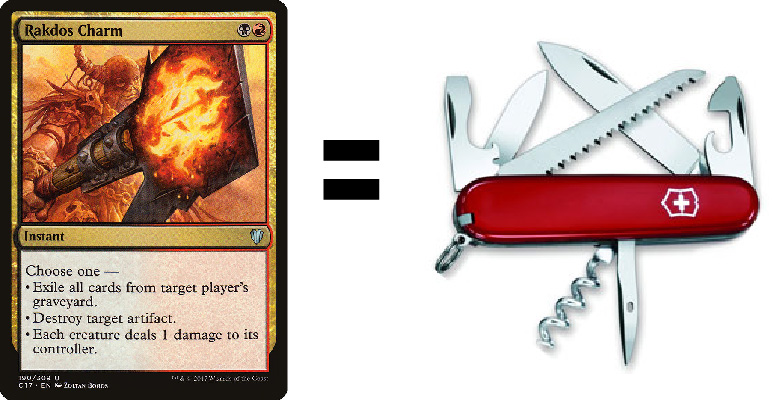
this card does it all
The first card I'd like to chat about is Rakdos CharmRakdos Charm. I play this in every red/black deck I build, and it always surpasses my expectations. This is a card that is only in 31% of lists on EDHREC and seems to be generally eclipsed by VandalblastVandalblast (43% of lists), but it does so much more than 'blast. Imagine you’re in a game with some of the other most popular commanders: Meren, of Clan Nel TothMeren, of Clan Nel Toth, Atraxa, Praetors’ VoiceAtraxa, Praetors’ Voice, and Edgar MarkovEdgar Markov (who is apparently too badass for an epitaph.) In this scenario we’re assuming that all the decks are built in their most popular ways, so by EDHREC’s standards that would be: generic reanimator, “tribal” +1/+1 counters, and tribal vampires. In this scenario having both VandalblastVandalblast and Rakdos CharmRakdos Charm in your list is just a waste of a card slot. Depending on the how the Atraxa player has built their deck you may wish you had blast once a game, but charm can just as easily break up an important combo piece, while keeping you in the good graces of the other players for not causing their mana rocks to become collateral. Charm serves the ultimate triple duty here as it can also outright kill the Edgar player if they go too wide, and it can shut down the Meren player for a couple turns if their graveyard gets too out of hand.
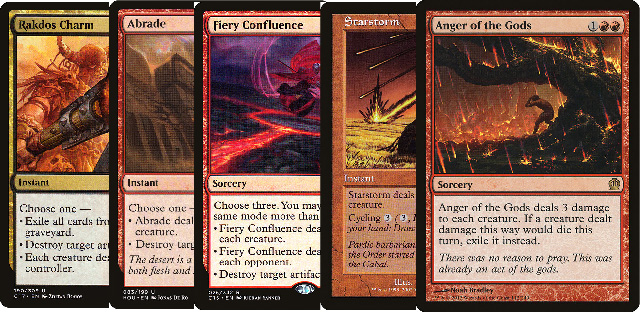
Having overlapping effects on our modal spells means we should always have the right tools for the job. Fiery ConfluenceFiery Confluence works as a backup ShatterShatter for when we have already had to use our Rakdos CharmRakdos Charm to keep both Meren and Karandor in check, but the Daretti, Scrap SavantDaretti, Scrap Savant player has just rebuilt and we’re in trouble again. It also pulls double-duty as a pseudo-wrath effect for when our opponents are trying to swarm the board. Getting a wrath-effect on a modal spell is pretty hard to come buy and I am very surprised to see that only 15 total decks are running this card. In terms of duplication, this is truly the only modal wrath we can run. The others aren’t in our colors (Austere CommandAustere Command I’m looking at you), sadly. Of the other wraths I have in the list, two have a hidden feature though: Decree of PainDecree of Pain and StarstormStarstorm both have cycling, which means that when I don’t need them they can actually act like a modal spell who’s other mode is simply “draw a card”. This may seem innocuous, but it can really help you keep your card velocity high in games where you’d otherwise stall out with DamnationDamnation stranded in your hand.
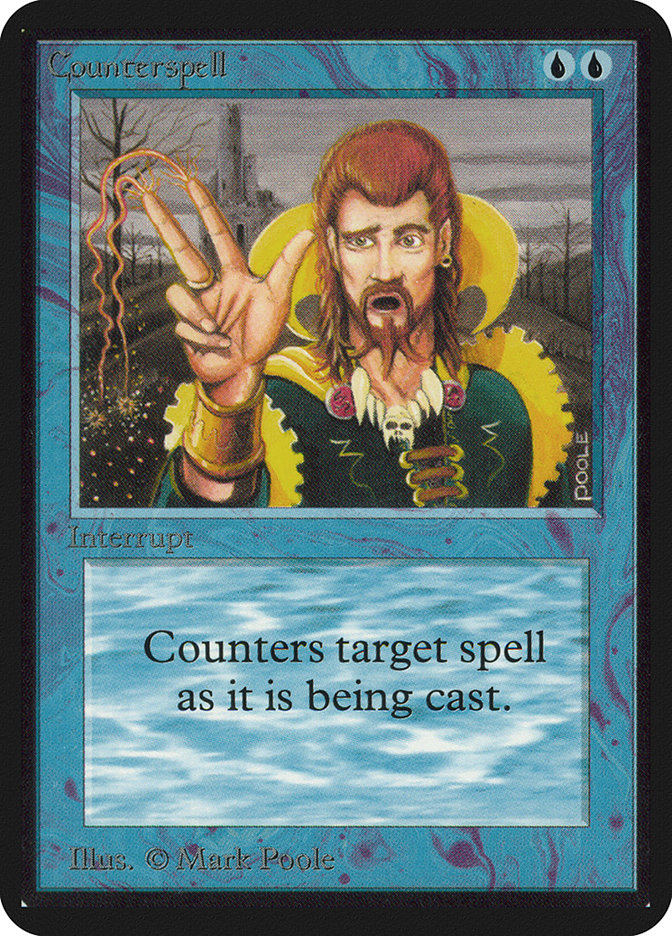
This card is as awkward as the look on this guy's face
While I’m on the subject of the confluence cycle I’d like to ask Kess players what the deal is with only 18% of them playing Mystic ConfluenceMystic Confluence, the best modal spell ever printed for Commander (fite me m8), and a whopping 12 people playing Wretched ConfluenceWretched Confluence. These spells are categorically amazing. Both can draw positive on cards. Both can act as various forms of removal when necessary, and they each provide an additional mode that is either protection against a game-ending spell, or recursion for one of the few, but powerful, creatures we have in the deck. Mystic ConfluenceMystic Confluence in particular is hard for me to follow when 63% of people are playing literal CouterspellCouterspell the card in their decks. This is a card that has 0 synergy with your commander and yet over half the population wants to run it. Sure, I get that clearly a large portion of the people playing Kess are playing a storm deck, Cabal RitualCabal Ritual is in 36% of the decks. That’s too many to be an accident. While a storm deck may care more about countering spells on its own turn than on opponents' turns, it still makes me wonder why they wouldn’t want access to a card that gives them as many options as Mystic ConfluenceMystic Confluence does. It must simply be the CMC of the spell, which is admittedly high. I still don’t think this makes it worse than CounterspellCounterspell in that slot. In fact I really don’t think there’s anything worse than strict counterspells in this deck. They are anti-synergistic with Kess to the point that they detract from the rest of the cards in your hand. Forcing you to play strange lines where you hope to bait opponents into casting spells on your turn to get Kess value out of your couterspells, when instead you could just be playing more removal which would be easily repeatable when needed. The only counterspell I’ve left in is the one which stays in your hand, ForbidForbid, and coincidentally also helps to fill your graveyard for Kess.
I’ve added a few personal touches to the list as well. Spells that I’ve been wanting to find a home but haven’t yet. Rite of RuinationRite of Ruination is one that I’m particularly excited to try out. This feels like it has a much more sinister edge when you can threaten your opponents with recurring it immediately after casting it. If the results of the first time around aren’t to your liking just give it another whirl. This deck plays a pretty solid amount of non-land ramp with the signets and cards that reduce cost like Goblin ElectromanerGoblin Electromaner so there’s always the truly evil option of going after your opponents’ lands. I’m also playing the super powerful, oft unused, Volcanic OfferingVolcanic Offering, for more land destruction evilness.
The "Badstuff"
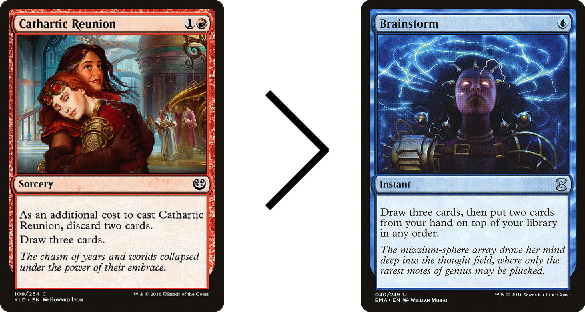
I think I haven’t mentioned a couple of cards that I excluded that are worth a few words. The most obvious exclusions are those cards with greater than 60% inclusion in lists on EDHRC, namely: PonderPonder, PreordainPreordain, and BrainstormBrainstorm. They are great at getting you further into your deck, and because they’re very easy to recur with Kess for some quick advantage while still leaving room for you to cast big, impactful spells. My one issue with cards like this is that they only serve a single purpose: getting cards into your hand regardless of quality. In place of these I’ve included the effects like Faithless LootingFaithless Looting, Izzet CharmIzzet Charm, and Cathartic ReunionCathartic Reunion which not only get cards into your hand cheaply, but can also serve double-duty filling your graveyard. Because they require you to discard cards they actually put more cards directly into your hand which gives you more freedom to work with what you find. Having cards go to your graveyard is actually not a drawback with this deck, so there’s really no downside to running these over their more popular counterparts.
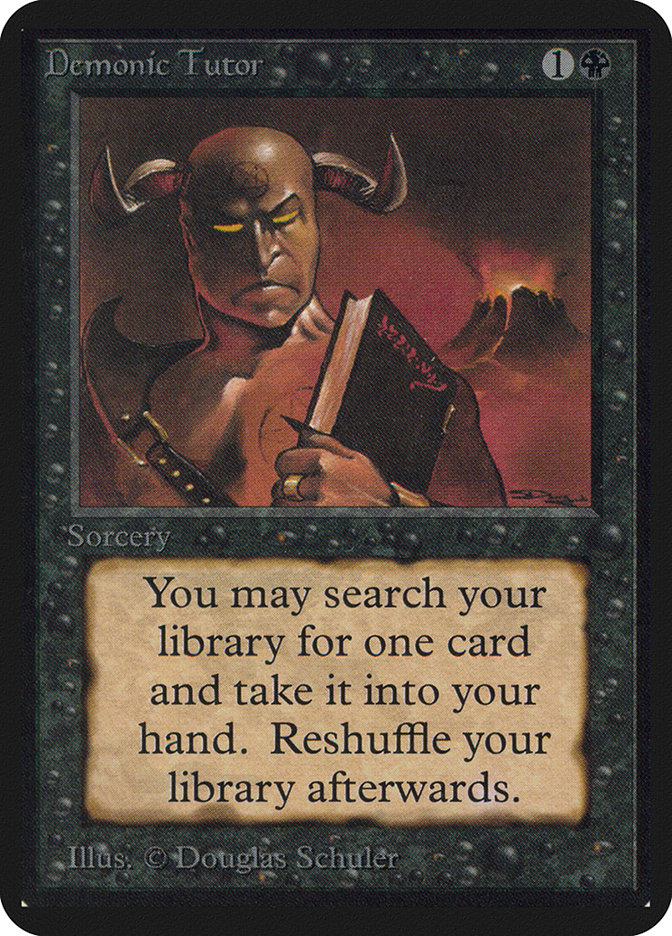
easy mode is for chumps
Finally I’ve excluded the face-down tutors (and basically all tutors other than GambleGamble which is too good in this deck to not run, and functions more like the looting spells above than a tutor anyways.) This is more personal preference than anything, but I think part of the fun of a control deck is the struggle of having to work to beat your opponents. If you’re always going to have the answer for whatever your opponent is doing because you have Demonic TutorDemonic Tutor in your hand, what’s the point of playing control in the first place? Why not just play a combo deck? This is a conclusion that a lot of Kess players are clearly coming to as the decks on EDHREC are replete with storm cards. But to these players I say, ‘you’re missing all the fun’. Embrace the chaos and let the cards break in your favor. Outplaying your opponent isn’t having DT up to find DamnationDamnation all the time; it’s when you correctly sequence spells like ForbidForbid into Forbidden AlchemyForbidden Alchemy but hold back on Looting to refill when you notice that the player to your left has been eyeing your graveyard the entire game and you just know he’s going to have a Relic of ProgenitusRelic of Progenitus ready.
Hopefully you like this deck as much as I do. That’s it for this month. Kess players feel free to fight me in the comments below.
Sam Alpert
Sam Alpert is an EDH filthy casual who's enjoyed magic for the past 14 years. He prefers games that last 25-40 minutes and don't involve Grip of Chaos. In his non-magic life he studies meteorites to descry the history of our solar system.
Your opinions are welcome. We love hearing what you think about Magic! We ask that you are always respectful when commenting. Please keep in mind how your comments could be interpreted by others. Personal attacks on our writers or other commenters will not be tolerated. Your comments may be removed if your language could be interpreted as aggressive or disrespectful. You may also be banned from writing further comments.
